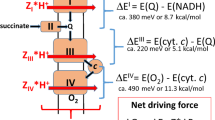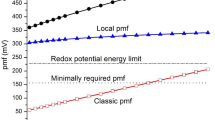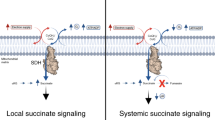Abstract
THE existence of an electrical potential difference at the mitochondrial membrane is one of the postulates of Mitchell's chemiosmotic theory of oxidative phosphorylation1,2. A shunting of the mitochondrial membrane leads to the uncoupling of oxidative phosphorylation. It has been demonstrated that uncoupling agents increase the proton permeability of phospholipid micelle membranes3 and artificial bimolecular membranes4–7. Mitchell and Moyle8 showed that uncouplers can operate as proton carriers in mitochondrial membranes.
This is a preview of subscription content, access via your institution
Access options
Subscribe to this journal
Receive 51 print issues and online access
$199.00 per year
only $3.90 per issue
Buy this article
- Purchase on Springer Link
- Instant access to full article PDF
Prices may be subject to local taxes which are calculated during checkout
Similar content being viewed by others
References
Mitchell, P., Nature, 191, 144 (1961).
Mitchell, P., Chemiosmotic Coupling in Oxidative and Photosynthetic Phosphorylation (Glynn Research Laboratories, Bodmin, 1966).
Chappell, J. B., and Haarhoff, K. N., in Biochemistry of Mitochondria (edit. by Slater, E. C., Kaniuga, Z., and Wojctzak, L.), 75 (Academic Press, London, 1967).
Liberman, E. A., Mokhova, E. N., Skulachev, V. P., and Topaly, V. P., Biofizika (USSR), 13, 188 (1968).
Skulachev, V. P., Sharaf, A. A., Yaguzhinsky, L. S., Jasaitis, A. A., Liberman, E. A., and Topaly, V. P., Currents in Modern Biology, 2, 98 (1968).
Liberman, E. A., and Topaly, V. P., Biofizika (USSR), 13, 1025 (1968).
Hopfer, U., Lehninger, A. L., and Thompson, T. E., Proc. US Nat. Acad. Sci., 59, 484 (1968).
Mitchell, P., and Moyle, J., Biochem. J., 105, 1147 (1967).
Hansen, M., and Smith, A. L., Biochim. Biophys. Acta, 81, 214 (1964).
Crane, F. L., Gleen, J. L., and Green, D. E., Biochim. Biophys. Acta, 28, 475 (1956).
Mueller, P., Rudin, D. O., Tien, H. T., and Wescott, W. C., J. Phys. Chem., 67, 534 (1963).
Liberman, E. A., and Topaly, V. P., Biofizika (USSR), 14, 562 (1969).
Moore, C., and Pressman, B. C., Biochem. Biophys. Res. Commun., 15, 562 (1964).
Chappell, J. B., and Crofts, A. R., in Regulation of Metabolic Processes in Mitochondria (edit. by Tager, J. M., Papa, S., Quagliarello, E., and Slater, E. C.), 293 (Elsevier, Amsterdam, 1966).
Mitchell, P., and Moyle, J., in Biochemistry of Mitochondria (edit. by Slater, E. C., Kaniuga, Z., and Wojtczak, Z.), 53 (Academic Press, London, 1967).
Author information
Authors and Affiliations
Rights and permissions
About this article
Cite this article
LIBERMAN, E., TOPALY, V., TSOFINA, L. et al. Mechanism of Coupling of Oxidative Phosphorylation and the Membrane Potential of Mitochondria. Nature 222, 1076–1078 (1969). https://doi.org/10.1038/2221076a0
Received:
Revised:
Issue Date:
DOI: https://doi.org/10.1038/2221076a0
This article is cited by
-
Conjugating uncoupler compounds with hydrophobic hydrocarbon chains to achieve adipose tissue selective drug accumulation
Scientific Reports (2024)
-
Contributions and Limitations of Mitochondria-Targeted and Non-Targeted Antioxidants in the Treatment of Parkinsonism: an Updated Review
Neurotoxicity Research (2022)
-
Phototoxicity of BODIPY in long-term imaging can be reduced by intramolecular motion
Photochemical & Photobiological Sciences (2022)
-
Expression of BAG1 is associated with prognosis in kidney renal clear cell carcinoma based on bioinformatics
BMC Cancer (2021)
-
Synthesis and tumour cell uptake studies of gadolinium(III)–phosphonium complexes
Scientific Reports (2021)
Comments
By submitting a comment you agree to abide by our Terms and Community Guidelines. If you find something abusive or that does not comply with our terms or guidelines please flag it as inappropriate.



